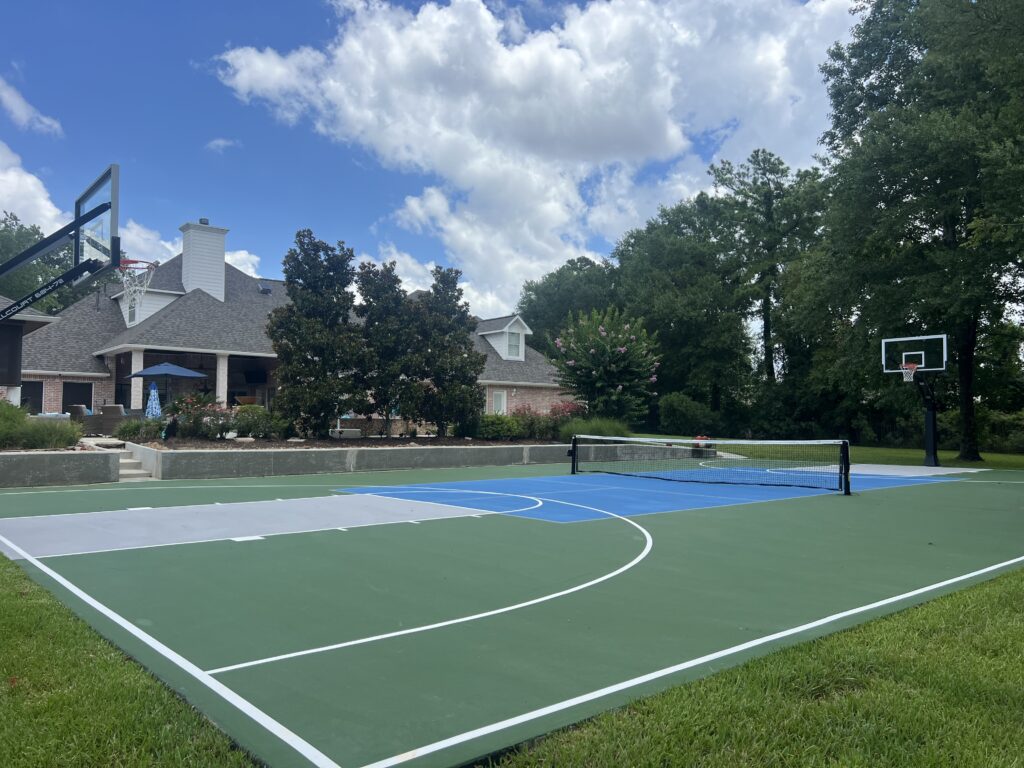January 17, 2025
Gustavo Rodriguez
Alternative to Traditional Painting
Historically sports surfacing with acrylic paint has been the way to add color, gamelines, and grip to a hard sports surface. While acrylic painting is an excellent option to add aesthetic value especially for those playing at a higher level who want to mimic the bounce of indoor hardwood flooring, sports tiles offer an alternative that is cost
effective, weather resistant, and highly
customizable.
Design
Sports tiles are made of rubber, polypropylene, or
PVC plastic that interlock. This interlocking design
allows the court to expand and contract with heat
and freeze cycles without buckling or breaking apart.
Some tile systems are fully floating, while others are
anchored along two sides, and others are stretched
out taut and anchored all around,
2
Advantages
Tile courts can conform to the planarity of the surface they are laid on top of helping to avoid puddles on the play surface and can help hide minor low areas not possible with acrylic sports painting. This allows courts that require patching for painting to be covered with tiles with minimal preparation work.
Durability is typically higher as sports tiles count on higher UV resistance and tend to last longer than court painting which will begin to fade and peel over time or under harsh weather conditions.
Shock absorption on tile courts is higher than that of a traditional painted court. They provide cushioning that helps reduce injury. Some tiles have built in shock absorption material that further reduces impact while maintaining playability.
Installation can be accomplished without specialized painting skills and done in less time. As most tile sport courts are assembled, painted, and disassembled during production,, the product arrives ready to install without the need for major court preparation and painting based on suitable weather. Tile sports courts can be put to use immediately after assembling where painted courts need a few days of curing before exposure to friction from play.
Maintenance can be less necessary on a tile court. If a tile is damaged it can be replaced individually instead of a full resurfacing or an obvious repair patch required with court painting. A tile court can handle longer periods of neglect without adverse effects where a painted court will begin to degrade and flake if organic matter such as moss, leaves, and standing water is allowed to linger on the surface. More care is needed to clean a painted court in order to not strip or fade the coating.
Modifications are possible in the event a court is expanded simply by adding more tiles or painting new game lines onto the surface.
Disadvantages
Since tile courts are made up of individual square tiles, they work best in rectangular spaces that are truly square. If the space they are being installed over is not square, it will become very obvious to the eye that something is off. This can be mitigated by cutting the tiles to conform
3
with the irregular surface, but this adds significant labor costs and waste as the court will have to be ordered oversized in order to achieve full coverage.
A painted court allows for full coverage of the irregular area and allows construction errors to be less noticeable. Less labor is involved and nothing is wasted to cover the area.
In areas prone to flooding or high cross winds, it’s necessary to anchor tile courts down to prevent shifting as high winds and deep water can allow the court to float from its original position.
Sports requiring robust and consistent bounce are affected when played on sports tiles. There are tiles specifically designed for use with racquet sports such as tennis and pickleball, but some more advanced players may not be fully satisfied with the difference in speed, bounce, and consistency.
Major modifications such as color changes or reorienting of game lines are not possible without purchasing more tiles. A painted court can be renewed with a few coats of resurfacer, but a tile court will require partial or total replacement of tiles. This also creates waste as the old tiles need to be disposed of.
Worthy Alternative
While a tile court may not make sense at the professional or collegiate level, they are great alternatives for those looking to transform and update an old sport surface that may have needed extensive repairs or total demolition to be painted again. Sports tiles are a great way to extend the life of a court or to bring life to a new court with the benefits of shock absorption, ease of installation, durability, and minimal maintenance . Errors in installation can easily be rectified with no permanent repercussions. They can be disassembled and moved with ease allowing flexibility without permanence.

